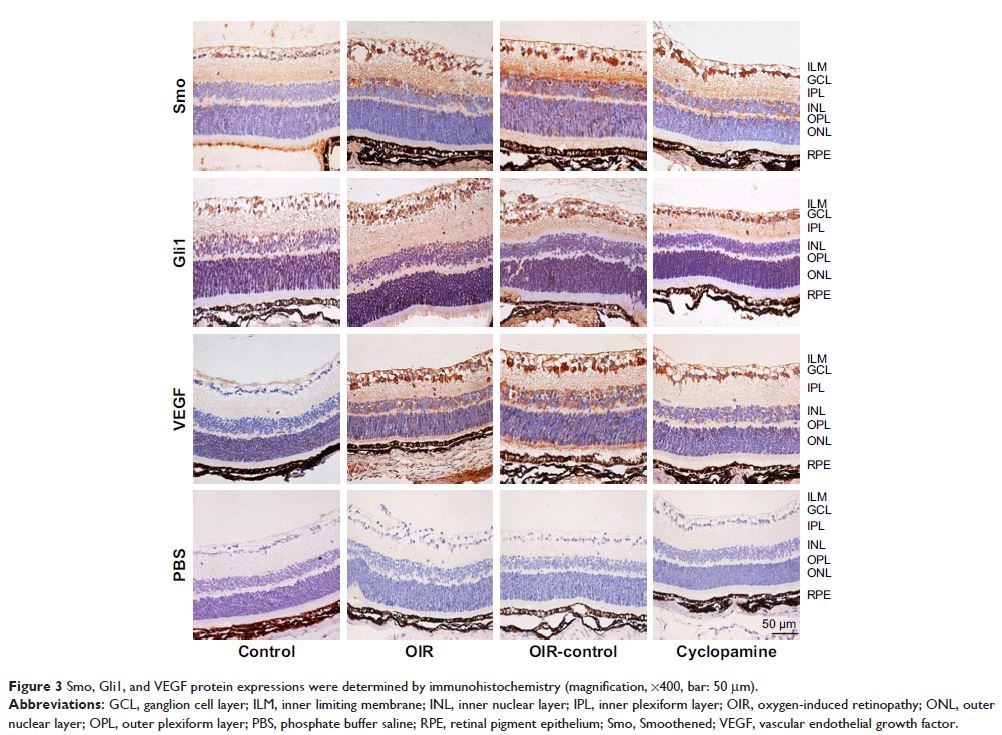108384
论文已发表
注册即可获取德孚的最新动态
IF 收录期刊
- 3.4 Breast Cancer (Dove Med Press)
- 3.2 Clin Epidemiol
- 2.6 Cancer Manag Res
- 2.9 Infect Drug Resist
- 3.7 Clin Interv Aging
- 5.1 Drug Des Dev Ther
- 3.1 Int J Chronic Obstr
- 6.6 Int J Nanomed
- 2.6 Int J Women's Health
- 2.9 Neuropsych Dis Treat
- 2.8 OncoTargets Ther
- 2.0 Patient Prefer Adher
- 2.2 Ther Clin Risk Manag
- 2.5 J Pain Res
- 3.0 Diabet Metab Synd Ob
- 3.2 Psychol Res Behav Ma
- 3.4 Nat Sci Sleep
- 1.8 Pharmgenomics Pers Med
- 2.0 Risk Manag Healthc Policy
- 4.1 J Inflamm Res
- 2.0 Int J Gen Med
- 3.4 J Hepatocell Carcinoma
- 3.0 J Asthma Allergy
- 2.2 Clin Cosmet Investig Dermatol
- 2.4 J Multidiscip Healthc

Hedgehog 信号转导通路在氧诱导小鼠视网膜新生血管中的表达和意义
Authors Liu ML, Chen XL, Liu HN, Di Y
Received 20 August 2017
Accepted for publication 31 October 2017
Published 21 May 2018 Volume 2018:12 Pages 1337—1346
DOI https://doi.org/10.2147/DDDT.S149594
Checked for plagiarism Yes
Review by Single-blind
Peer reviewers approved by Dr Junhua Mai
Peer reviewer comments 2
Editor who approved publication: Professor Manfred Ogris
Aim: The aim of the study was to investigate the signal transduction
mechanism of Hedgehog–vascular endothelial growth factor in oxygen-induced
retinopathy (OIR) and the effects of cyclopamine on OIR.
Methods: An OIR model was established in C57BL/6J mice exposed to
hyperoxia. Two hundred mice were randomly divided into a control group, an OIR
group, an OIR-control group (treated with isometric phosphate-buffered saline
by intravitreal injection), and a cyclopamine group (treated with cyclopamine by
intravitreal injection), with 50 mice in each group. The retinal vascular
morphology was observed using adenosine diphosphatase and number counting using
hematoxylin and eosin-stained image. Quantitative real-time quantitative
polymerase chain reaction was used to detect mRNA expression. Protein location
and expression were evaluated using immunohistochemistry and Western
blot.
Results: The OIR group and OIR-control group demonstrated large-area
pathological neovascularization and nonperfused area when compared with the
control group (both P <0.05). The
area of nonperfusion and neovascularization in the cyclopamine group was
significantly reduced compared with the OIR and OIR-control groups (both P <0.05). Compared with the
control group, the OIR and OIR-control groups had more vascular endothelial
cells breaking through the inner limiting membrane. The number of new blood
vessel endothelial cell nuclei in the cyclopamine group was significantly
reduced (both P <0.05) when
compared with the OIR and OIR-control groups. The mRNA and protein expressions
of Smoothened, Gli1, and vascular endothelial growth factor in the signal
pathway of the OIR and OIR-control groups were significantly higher than those
of the control group; however, in the cyclopamine group, these factors were
reduced when compared with the OIR and OIR-control groups (all P <0.05).
Conclusion: Our data suggest that abnormal expression of the Hedgehog
signaling pathway may be closely associated with the formation of OIR.
Inhibiting the Smoothened receptor using cyclopamine could control retinal
neovascularization, providing new ideas and measures for the prevention of
oxygen-induced retinal neovascularization.
Keywords: Hedgehog signaling pathway, neovascularization, oxygen-induced
retinopathy, retinopathy of prematurity, cyclopamine
